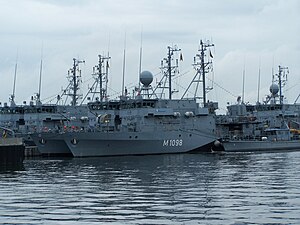Ensdorf-class minesweeper (original) (raw)
From Wikipedia, the free encyclopedia
 M1098 Siegburg, at the Kiel Week 2007 M1098 Siegburg, at the Kiel Week 2007 |
|
|---|---|
| Class overview | |
| Name | Type 352 Ensdorf class |
| Builders | Lürssen Abeking & Rasmussen |
| Operators |  German Navy German Navy |
| Preceded by | Hameln class |
| Built | 1999-2001 |
| Completed | 5 |
| Laid up | 5 |
| General characteristics | |
| Type | Minesweeper |
| Displacement | 650 tonnes |
| Length | 54.40 m (178.5 ft) |
| Beam | 9.20 m (30.2 ft) |
| Draft | 2.84 m (9 ft 4 in) |
| Propulsion | 2 × MTU 16V 538 TB91 diesel engines, 2240 kW each 2 × Renk PLS 25 gearboxes 2 × propeller shafts driving controllable pitch propellers |
| Speed | 18 knots (33 km/h; 21 mph) |
| Complement | 45 |
| Sensors and processing systems | Navigation radar Hull-mounted DSQS-11 mine-detection sonar |
| Armament | 2 × Bofors 40mm/L70 dual-purpose gun (to be upgraded to 2 Mauser MLG27 27 mm remote-controlled autocannons) FIM-92 Stinger surface-to-air missiles (MANPADS) Mine-laying capabilities (60 mines) |
Type 352 _Ensdorf_-class minesweepers are a class of five minesweepers of the German Navy. They are Type 343 _Hameln_-class minesweepers that have been upgraded with the Troika Plus system of minesweeping drones
The Ensdorf class have three modes to clear mine fields:
- Troika Plus: This system employs up to four remote controlled Seehund ("seal") drones which perform the sweep. The drones are small unmanned boats that can simulate the acoustic and magnetic signatures of bigger ships to trigger mines. Their small size and special construction let them survive the effects of exploding mines unharmed.
- Mine hunting: Mines detected with the hull-mounted sonar can be identified and exploded with expendable Seefuchs (Seafox) ROVs.
- Classical minesweeping: Against moored mines the classical minesweeping using towed wire cutters to cut the anchors of mines can be conducted.
The Ensdorf class replaced the Type 351 _Lindau_-class minesweepers in service with the German Navy.
Three Seehund ROVs
The Seehund unmanned surface vehicles can be controlled remotely or manually by an onboard crew (usually three) for maneuvering in harbours or in training (the Seehund is too large to be carried by _Ensdorf_-class vessels). A life raft is carried for this reason. _Seehund_s are 25 m (82 ft) long with a displacement of 99 t. They are propelled by a Schottel Z-drive which gives them a maximum speed of 9–10 kn (17–19 km/h; 10–12 mph).
| Pennant number | Name | Call sign | Commissioned | Decommissioned |
|---|---|---|---|---|
| M1094 | Ensdorf | DRFN | 16 October 1990 | 31 July 2014 |
| M1093 | Auerbach/Oberpfalz | DRFR | 7 May 1991 | 17 December 2015 |
| M1092 | Hameln | DRFO | 29 June 1989 | 11 December 2014 |
| M1090 | Pegnitz | DRFT | 8 March 1990 | |
| M1098 | Siegburg | DRFL | 26 July 1990 |
- The ships were not decommissioned for their rebuilding to Type 352, so the listed dates are the ones of their commission as Type 343.
- Auerbach/Oberpfalz is one single name.
- The ships currently belong to the 5. Minensuchgeschwader (5th Mine Sweeping Squadron) based in Kiel at the Baltic Sea.
| Number | Commissioned | Mothership |
|---|---|---|
| 1 | 5 May 1981 | M1092 Hameln |
| 2 | 5 May 1981 | M1092 Hameln |
| 3 | 5 May 1981 | M1092 Hameln |
| 4 | 4 March 1982 | M1093 Auerbach/Oberpfalz |
| 5 | 4 March 1982 | M1093 Auerbach/Oberpfalz |
| 6 | 4 March 1982 | M1093 Auerbach/Oberpfalz |
| 7 | 17 September 1981 | M1098 Siegburg |
| 8 | 17 September 1981 | M1098 Siegburg |
| 9 | 17 September 1981 | M1098 Siegburg |
| 10 | 11 November 1981 | M1098 Siegburg |
| 11 | 11 November 1981 | M1092 Hameln |
| 12 | 11 November 1981 | M1090 Pegnitz |
| 13 | 24 May 1982 | M1090 Pegnitz |
| 14 | 24 May 1982 | M1090 Pegnitz |
| 15 | 24 May 1982 | M1090 Pegnitz |
| 16 | 7 November 1983 | M1094 Ensdorf |
| 17 | 7 November 1983 | M1094 Ensdorf |
| 18 | 7 November 1983 | M1094 Ensdorf |
The Seehunde ROVs were taken from the six decommissioned Type 351 class, which means that they are older than their motherships.
- "Hohlstablenkboot ENSDORF-Klasse". Deutsche Marine. Retrieved 4 August 2008.
